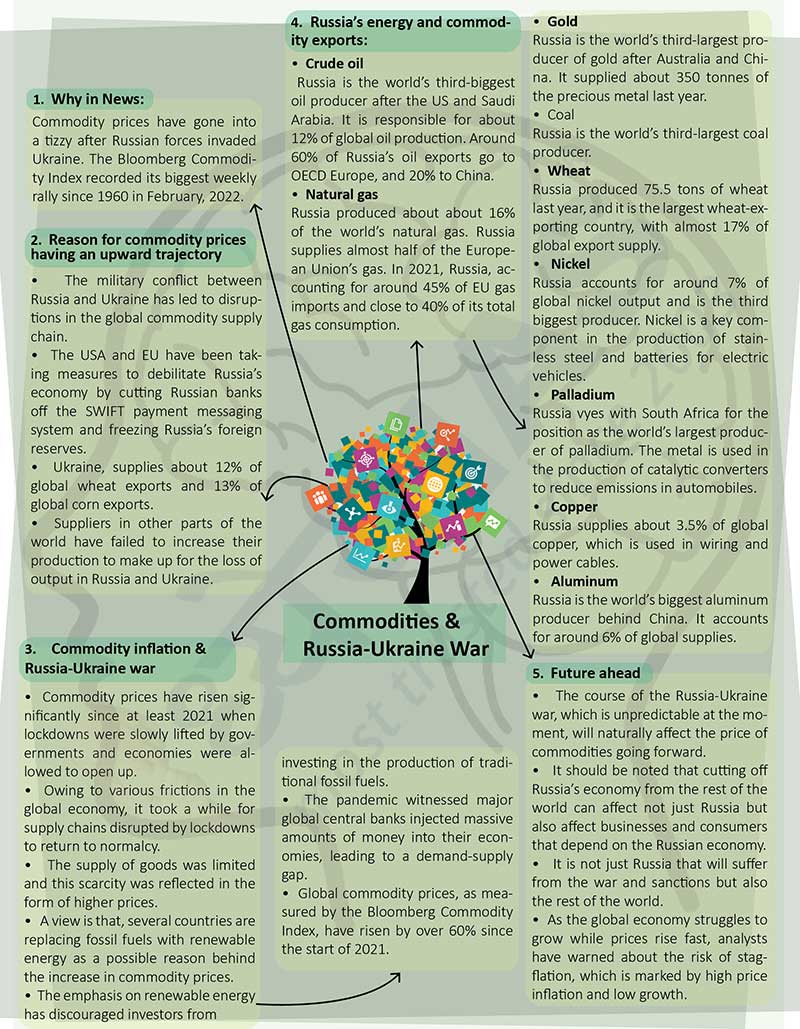Brain-booster /
10 Apr 2022
Brain Booster for UPSC & State PCS Examination (Topic: Commodities & Russia-Ukraine War)

Why in News?
- Commodity prices have gone into a tizzy after Russian forces invaded
Ukraine. The Bloomberg Commodity Index recorded its biggest weekly rally
since 1960 in February, 2022.
Reason for commodity prices having an upward trajectory
- The military conflict between Russia and Ukraine has led to disruptions
in the global commodity supply chain.
- The USA and EU have been taking measures to debilitate Russia’s economy
by cutting Russian banks off the SWIFT payment messaging system and freezing
Russia’s foreign reserves.
- Ukraine, supplies about 12% of global wheat exports and 13% of global
corn exports.
- Suppliers in other parts of the world have failed to increase their
production to make up for the loss of output in Russia and Ukraine.
Commodity inflation & Russia-Ukraine war
- Commodity prices have risen significantly since at least 2021 when
lockdowns were slowly lifted by governments and economies were allowed to
open up.
- Owing to various frictions in the global economy, it took a while for
supply chains disrupted by lockdowns to return to normalcy.
- The supply of goods was limited and this scarcity was reflected in the
form of higher prices.
- A view is that, several countries are replacing fossil fuels with
renewable energy as a possible reason behind the increase in commodity
prices.
- The emphasis on renewable energy has discouraged investors from
investing in the production of traditional fossil fuels.
- The pandemic witnessed major global central banks injected massive
amounts of money into their economies, leading to a demand-supply gap.
- Global commodity prices, as measured by the Bloomberg Commodity Index,
have risen by over 60% since the start of 2021.
Russia’s energy and commodity exports:
Crude oil
- Russia is the world’s third-biggest oil producer after the US and Saudi
Arabia. It is responsible for about 12% of global oil production. Around 60%
of Russia’s oil exports go to OECD Europe, and 20% to China.
Natural gas
- Russia produced about about 16% of the world’s natural gas. Russia
supplies almost half of the European Union’s gas. In 2021, Russia,
accounting for around 45% of EU gas imports and close to 40% of its total
gas consumption.
Gold
- Russia is the world’s third-largest producer of gold after Australia and
China. It supplied about 350 tonnes of the precious metal last year.
Coal
- Russia is the world’s third-largest coal producer.
Wheat
- Russia produced 75.5 tons of wheat last year, and it is the largest
wheat-exporting country, with almost 17% of global export supply.
Nickel
- Russia accounts for around 7% of global nickel output and is the third
biggest producer. Nickel is a key component in the production of stainless
steel and batteries for electric vehicles.
Palladium
- Russia vyes with South Africa for the position as the world’s largest
producer of palladium. The metal is used in the production of catalytic
converters to reduce emissions in automobiles.
Copper
- Russia supplies about 3.5% of global copper, which is used in wiring and
power cables.
Aluminum
- Russia is the world’s biggest aluminum producer behind China. It
accounts for around 6% of global supplies.
Future ahead
- The course of the Russia-Ukraine war, which is unpredictable at the
moment, will naturally affect the price of commodities going forward.
- It should be noted that cutting off Russia’s economy from the rest of
the world can affect not just Russia but also affect businesses and
consumers that depend on the Russian economy.
- It is not just Russia that will suffer from the war and sanctions but
also the rest of the world.
- As the global economy struggles to grow while prices rise fast, analysts
have warned about the risk of stagflation, which is marked by high price
inflation and low growth.







